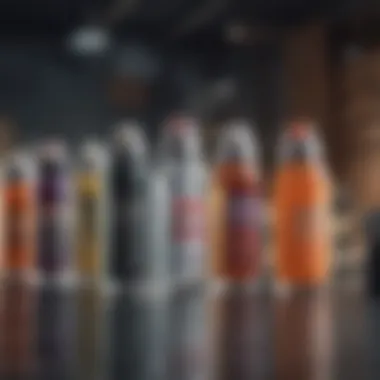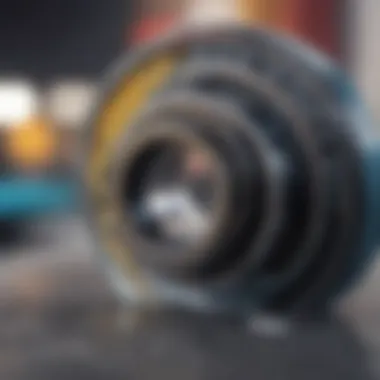Choosing the Right Lubricant for Skateboard Bearings


Intro
Proper lubrication of skateboard bearings is a critical component often overlooked by both amateur and seasoned skaters alike. Think of bearings as the unsung heroes in the world of skateboarding; without smooth operation, a rider's experience could be hindered by noise and friction, resulting in reduced performance and increased wear. The right lubricant can significantly enhance a skater's ride, providing not only a faster glide but also prolonging the life of the bearings themselves.
In this exploration, we’ll delve into the various types of lubricants available for skateboard bearings, drawing out their unique attributes and applications. From oil-based solutions to greases, knowing how to select the most appropriate lubricant can make the difference between a rewarding session at the skate park and a frustrating struggle against a stubborn skateboard. We’ll also touch on practical considerations, helping every skater—from novices to pros—make informed decisions that align with their riding style and maintenance routines.
As we navigate through the details, we aim to equip you with essential knowledge. So, whether you're out to master new tricks or just improve overall performance, understanding lubrication will lay the groundwork for a smoother, more enjoyable ride.
Foreword to Skateboard Bearings
In the world of skateboarding, bearings are the unsung heroes that often fly under the radar. Understanding skateboard bearings is crucial for anyone eager to enhance their riding experience. These small but mighty components play a pivotal role in how smoothly and efficiently a skateboard rolls. From the sound of the wheels to the speed you can muster when you push off, bearings can make a significant difference.
Understanding the Role of Bearings
Bearings serve the essential function of allowing the wheels to rotate freely on the axles. Think of them as the tiny engines that make your skateboard glide like butter on a hot skillet. Their efficiency can directly impact performance — poor-quality bearings can create a rough ride filled with jitters where smoothness is desired. A well-lubricated bearing, on the other hand, minimizes friction, enabling skateboards to coast smoothly, which is especially beneficial for tricks and downhill rides.
Types of Skateboard Bearings
Diving into the types of skateboard bearings can help in selecting ones that best suit your skating needs. In this arena, familiarity with features like ratings and materials can arm a skater with the knowledge needed to make informed choices.
Abec ratings explained
Abec ratings dictate the precision and tolerance of a bearing. For example, an ABEC-1 is less accurate than an ABEC-7. Higher ABEC ratings typically imply smoother and faster bearings, making this a sought-after avenue for performance-oriented skaters. However, it should be noted that higher isn’t always better; the real question is whether a skater's style justifies the expense. ABEC ratings also don’t account for all factors related to the overall performance, such as durability and weather resistance, which can depend more on the environment rather than the numbers on the packaging.
Sealed vs. unsealed bearings
When choosing between sealed and unsealed bearings, skaters must assess their skating habits. Sealed bearings come with dust shields that block out dirt and debris, prolonging their lifespan. In contrast, unsealed bearings allow for easier maintenance and cleaning, which can result in longer periods of optimal performance if managed well. Ultimately, this choice hinges on a skater's willingness to engage in regular upkeep versus a desire to let their bearings be, especially in messy environments.
Materials used in bearings
Lastly, the materials that make up bearings significantly influence performance and durability. Steel bearings are common due to their balance of strength and cost; however, ceramic bearings are becoming increasingly popular for their low friction and light weight. Each material presents its own set of pros and cons. While ceramic bearings can withstand higher speeds with less wear and tear, they come at a heftier price tag. The choice between materials should consider not only the skater's budget but also the environments in which they typically skate.
"Choosing the right bearings is like picking the right vehicle for your journey; it can either enhance or hinder your experience."
Understanding these fundamental aspects helps to streamline the selection process of skateboard bearings, ultimately contributing to better performance out on the streets or in the park.
Importance of Lubrication
Lubrication plays a pivotal role in maintaining the efficiency and longevity of skateboard bearings. Without proper lubrication, these small but crucial components can quickly succumb to wear, resulting in decreased performance and a choppy riding experience. The right lubricant not only facilitates smoother skating but also safeguards against environmental elements that can cause damage. Understanding this aspect empowers skateboarders to make informed choices that could significantly enhance their enjoyment and performance on the board.
How Lubrication Affects Performance
Reducing friction
Reducing friction is perhaps one of the most significant benefits of lubrication when it comes to skateboard bearings. Friction is the enemy of speed and efficiency. When bearings operate with low friction, they can spin freely, allowing for better acceleration and smoother glides. A lubricant that effectively lowers friction helps in maintaining a consistent speed, crucial for those quick maneuvers that street skaters thrive on. Factors like viscosity and additives in the oil contribute to its friction-reducing properties. While oil-based lubricants often offer the best results in this regard, attention must be paid to the thickness of the oil; if it's too thick, it might impede movement instead of aiding it.
Interestingly, some users have noted a drop in performance when opting for overly thick greases that fail to lower friction adequately. Thus, finding that sweet spot in lubricant choice can drastically influence how one experiences their ride.
Enhancing speed and glide
Enhancing speed and glide is another pertinent aspect of effective lubrication. A well-lubricated bearing allows a skateboard to slide effortlessly across various surfaces. This smoother interaction helps prevent stalling and creates a seamless transition between tricks and maneuvers. For enthusiasts who relish speed, using a lubricant designed for high-speed applications can make all the difference.
These specialized lubricants often contain additives that promote flow and reduce drag, thus allowing for a more vibrant skating experience. However, one must be cautious; while low-friction lubes can boost performance, skaters should consider the environment. A speed-enhancing lubricant may not perform as effectively in damp or gritty conditions, necessitating regular checks and possible reapplication.


Impact on Bearing Lifespan
Preventing wear and tear
Preventing wear and tear is essential to prolonging the lifespan of skateboard bearings. Lubricants create a protective film over the metallic surfaces within the bearings, which helps to halt the abrasive processes that lead to degradation. With regular lubrication, contaminants like dirt and moisture have less chance to infiltrate and cause corrosion or other damage.
A common recommendation is to inspect and clean your bearings before applying a fresh coat of lubricant. This process allows you to remove grit and grime that could impede the lubricant's effectiveness. By investing time in maintenance practices, skateboarders can effectively extend the time before needing to replace worn-out bearings.
Extending usability
Extending usability is another aspect that highlights the significance of lubrication. Well-maintained bearings not only perform better but also require less frequent replacements, making them more cost-effective over time. A skateboarder who regularly lubricates their bearings does not have to worry as much about the costs associated with frequent replacements. Instead, they can focus on enjoying their time on the board without interruptions.
Furthermore, certain lubricants can protect bearings against environmental stressors, like those experienced during skate sessions in humid weather. However, it's crucial to recognize that even the best lubricants cannot make bearings invincible. Skaters still need to be vigilant about maintenance habits and consider their skating conditions to keep their equipment in prime condition.
"Regular lubrication transforms your ride into a seamless experience, enhancing both performance and bearing lifespan."
In summary, understanding how lubrication impacts performance and lifespan is vital for any skateboarder. Missing the mark on this can lead to frustrating experiences and unnecessary costs. Armed with this knowledge, one can make smarter choices regarding not just the type of lubricant used but also how frequently one should maintain their bearings.
Types of Lubricants Available
When it comes to skateboard maintenance, understanding the various types of lubricants available is crucial. The right lubricant can significantly influence how fast your bearings spin and how long they last. Choosing the proper type ensures an optimal skating experience, giving you the performance edge during rides. Each lubricant type has its unique set of properties, and knowing which to use in different scenarios can lead to better skating outcomes. Here, we dive into three main categories of lubricants: oil-based, grease-based, and wax or ceramic lubricants.
Oil-Based Lubricants
Characteristics and benefits
Oil-based lubricants are popular in the skateboard community due to their effectiveness in reducing friction between moving parts. The texture of these lubricants tends to be thinner, allowing them to penetrate well into the small spaces of the bearings. This feature makes them useful for achieving higher speeds since less resistance is encountered. Furthermore, oil-based lubricants help in dispersing heat, which can accumulate during vigorous skating sessions.
One significant characteristic is their ability to provide a smooth glide, making it a beneficial choice for skaters looking to optimize their performance. However, one must also consider that oil-based substances require regular reapplication, particularly after exposure to moisture or heavy use which could wash them away.
Popular oil types
There are several oil types that skateboarders tend to favor. For example, light machine oils, like sewing machine oils, often find their way into the toolkit of many skaters. These oils excel due to their compatibility with most bearing systems and their ease of application.
Some well-known brands also produce specialized skateboard oils, which usually have additives that enhance performance. These oils can offer a longer-lasting effect and maintain better flow throughout the skate session. However, keep in mind that some oil types may come with a higher price tag.
Grease-Based Lubricants
Advantages of using grease
Grease serves as a heavyweight contender in the lubricant realm. Its thicker consistency provides several advantages, particularly in the context of skateboard bearings. The primary benefit is long-lasting protection. Grease can stick around even under heavy loads, making it perfect for skaters who frequently ride in less-than-ideal conditions.
Low maintenance is another key aspect of using grease. A well-packed bearing can go for a considerable time without needing lubrication. The downside, however, is that it might slow down the bearings a bit, so high-speed skaters may want to stay cautious when using it.
Common grease formulations
Skaters often select greases based on their specific formulations. Lithium-based greases are highly favored due to their water-resistant properties, which is particularly useful in wet environments. Likewise, synthetic greases provide excellent performance, especially under high heat or loads.
Both of these formulations are quite common in the skateboarding community. However, the thicker nature of grease can sometimes lead to challenges in application and might become sticky if not spread evenly, perhaps requiring more practice to use effectively.
Wax-Based and Ceramic Lubricants
Unique properties and uses
Wax-based lubricants stand out for their ability to create a dry film that minimizes dust attraction. This makes them a superb option for skaters who often find themselves skating in dirty or gritty conditions. Wax also preserves the bearings' natural rotation without causing a build-up that can often accompany oils or greases.


Ceramic lubricants are another innovative choice gaining traction. They are designed to reduce friction via their unique molecular structure, offering enhanced performance while also being more resistant to washing out. These types can be a bit pricier, but for enthusiasts committed to performance, the investment can be worthwhile.
Considerations when choosing
When it comes to picking a lubricant, it’s essential to consider a few factors. First on the list is the skating environment. If you’re skating in sandy or humid conditions, a wax-based or ceramic lubricant may serve you better. On the other end, if speed is your game, you might lean towards oil-based options.
Another point worth considering is how often you’re willing to maintain your skateboard. If you prefer a more hands-on approach, oils could be perfect. If not, grease might be more up your alley because of its longer-lasting nature. Ultimately, weighing the pros and cons unique to each lubricant type will guide you to the best decision for your skating needs.
Choosing the Right Lubricant
When it comes to skateboard bearings, the right lubricant can make all the difference. Choosing a lubricant isn’t just about picking up whatever is on sale; it’s about understanding the distinct dynamics of your skating style, the environment you skate in, and balancing cost with quality. Each of these elements influences not just how well your skateboard performs but also how long your bearings will last.
Assessing Your Skating Style
Freestyle vs. Street Skating
Freestyle skating is often characterized by fluid movements, tricks, and routines performed on flat surfaces or ramps. In contrast, street skating deals with more technical maneuvers on urban obstacles like ledges and rails. These differences significantly influence the kind of lubricant you might want to use.
For freestyle skaters, rapid directional changes are common. A thinner lubricant, like oils, might be advantageous here since they reduce drag and allow for quick transitions. Street skaters, on the other hand, may prefer a thicker grease that stays put under the constant stress and impact of urban environments. The advantage of thicker grease is that it offers better protection from dirt and debris, making it suitable for the challenging conditions of street skating.
Park Skating Considerations
Park skating is a blend of both freestyle and street styles, often performed in designated ramps and skateparks. This activity can involve heavier tricks, which means a more robust option might be appropriate. The key here is finding a lubricant that can handle both the speed and the impact without breaking down too quickly.
An effective lubricant for park skaters might combine qualities of oil and grease – something that allows for smooth transitions while still providing ample protection. One must consider the unique features of the skatepark, such as smooth surfaces or rough edges, as these can further influence your choice of lubricant.
Environmental Factors
Humidity and Temperature Effects
Environmental conditions play a significant role in how lubricant performs. High humidity can lead to excess moisture getting into your bearings, which can cause lubricants to degrade faster. A water-resistant or moisture-repellent lubricant can help counteract this issue. Meanwhile, extreme temperatures might affect the viscosity of the lubricant. Colder conditions can cause oil to thicken, while heat can cause grease to break down rapidly.
Finding a lubricant that remains stable under varying conditions is paramount. For example, a lubricant designed for high-temperature environments stands to benefit those skating in hot cities, as it minimizes the risk of poor performance due to melted grease.
Urban vs. Rural Conditions
The type of environment you skate in – urban or rural – can heavily affect your choice as well. Urban areas are typically dirtier, filled with debris that can contaminate bearings. Lubricants that provide sealing properties while withstanding pollution are ideal for city skaters. In contrast, rural conditions may involve exposure to elements like dust and sand, necessitating a lubricant that addresses those specific challenges.
Cost vs. Quality
Evaluating Price Points
When selecting a lubricant, you’ll often come across a range of price points. It’s tempting to go for the cheapest option, but understanding the correlation between price and performance is crucial. Generally, higher-quality lubricants might carry a heftier price tag, but they often provide better longevity and protection, saving you money in the long run. Considerations should include how often you need to replace or reapply the lubricant. Sometimes, investing a little more upfront means less hassle down the road.
Identifying Trusted Brands
In the world of skateboarding, reputation matters. Identifying trusted brands can provide peace of mind when choosing a lubricant. Established companies often have better quality control, conducting research and testing to ensure their products meet the demands of skaters. Look for brands that come recommended by fellow skaters or that have solid reviews in community discussions on platforms such as Reddit or specialized skating forums.
Always take time to research the brands, checking for user testimonials or expert reviews, as this can inform better purchasing decisions. Choosing the wrong product can lead to dissatisfaction and poor performance that even the best board can’t mitigate.
Remember, the right lubricant is an investment in your skate experience – pick wisely!
Application Techniques


When it comes to maintaining skateboard bearings, understanding the right application techniques cannot be overstated. Proper lubrication is vital not just for speed, but it plays a huge role in preserving the longevity of your bearings. Without the right approach to applying lubricant, skaters might find themselves dealing with poor performance and premature wear.
How to Properly Lubricate Bearings
Disassembling the bearings
Disassembling the bearings is a crucial first step in the lubrication process. This involves carefully removing the shields or seals to gain access to the internal components of the bearings. The beauty of disassembling lies in the ability to thoroughly clean each part before reapplying lubricant. Cleaning helps in eliminating dirt and old, degraded lubricant, which can significantly slow down performance.
- This process allows you to inspect the bearings for wear, ensuring you catch potential issues before they escalate. A thorough inspection can help prevent future breakdowns and ensure your skate session is as smooth as butter.
- However, it's worth bearing in mind that not all bearings are designed to be disassembled easily. Some sealed bearings may not be meant to be taken apart, which could lead to damage if forced. So, always check manufacturer guidelines to avoid mishaps.
Applying the lubricant
The next phase, applying the lubricant, is where the magic happens. The key characteristic to know is that less is often more. A small drop of lubricant in the right spot can lead to optimal performance without making everything gooey.
- For oil-based lubricants, you’ll want to use a precision applicator to get into the hard-to-reach places without overdoing it. An even application allows for a smooth glide, which enhances your skating experience.
- On the flip side, greasing up the bearings can lead to improved protection against dirt, especially in more hazardous environments. This method offers a thicker barrier, though it may require more maintenance since grease can attract dirt more easily than oil.
Reassembling and testing
Reassembling and testing is where you tie everything together. After applying the lubricant, put the bearings back together with care. Ensuring that everything clicks back into place properly makes a difference in how well the bearings perform.
- This step is a double-check on your work. It allows you to assess whether there were any complications during assembly. Skaters often overlook this, but it's essential that every part is aligned and secured to avoid future performance issues.
- Once everything is reassembled, easy tests like spinning the wheels can help you determine if the lubricant was applied correctly. Smooth and consistent spinning is what you’re looking for. If it’s still sluggish, you may need to start the process over or reconsider your lubricant choice.
Frequency of Lubrication
Signs your bearings need lubrication
Recognizing when your bearings need lubrication is all about observation. A couple of telltale signs can hint things aren’t quite right. First off, strange noises during skating are usually a red flag. If you hear grinding or squeaking, these sounds typically indicate that the bearings are lacking lubrication.
- Another clue might be noticeable resistance while trying to spin the wheels by hand. If the wheels aren’t gliding smoothly, it’s a sign that it’s time to act. Being proactive can save you time and money in repairs later on.
- Keep in mind, environmental factors come into play too. Riding in dusty or wet conditions can speed up the degradation of lubricant.
Recommendations for maintenance schedules
Creating a maintenance schedule for your bearings is a smart part of skate care. It keeps your bearings in peak condition.
- A popular approach might be to check and lube your bearings after every 10-15 skate sessions. This can vary based on the conditions you skate in.
- During colder months or rainy seasons, consider a shorter interval for maintenance, as moisture or abrasiveness can wear down your lubricant much faster.
Proper maintenance is not just about making your skateboard last, but it also enhances overall performance. You wouldn’t run a car on empty, right?
Staying on top of these small tasks can lead to a smoother ride and help you to enjoy skating without any hiccups.
Ending: The Path to Optimal Performance
In the ever-evolving world of skateboarding, having the right lubricant for your bearings plays a pivotal role in achieving peak performance. While many skateboarders focus on other aspects of their setup, such as deck strength or wheel hardness, the significance of proper lubrication often gets sidelined. The truth is, choosing the appropriate lubricant can lead to a noticeable difference, not only in the speed and smoothness of your ride but also in the longevity of your bearings.
Understanding the relationship between lubrication and performance is essential. When bearings run smoothly due to effective lubrication, skaters can enjoy an uninterrupted flow, allowing for fluid maneuvers and effortless gliding. Furthermore, a well-lubricated bearing system directly contributes to reducing wear and tear, enabling skaters to push their limits, whether it's mastering tricks in the park or cruising down city streets.
Ultimately, the choice of lubricant should reflect both the skater's personal style and the conditions in which they skate. By taking into account the environmental factors and adapting to different skating styles, one can enhance their overall experience on the board. It's about creating a harmonious balance between performance and longevity.
"Optimal performance isn’t merely about the skater; it’s intrinsically linked to how well a skateboard functions, and that starts with choosing the right lubricant."
Summary of Key Takeaways
- Selecting the right lubricant for skateboard bearings is crucial for enhancing ride quality and performance.
- Different lubricants serve unique purposes, such as oil for speed and grease for protection against dirt.
- Environmental conditions and individual skating styles play a significant role in your lubricant choice.
- Regular maintenance, including proper lubrication, can significantly extend the lifespan of your bearings.
- A well-maintained skateboard enables skaters to perform better and enjoy a smoother ride.
Final Recommendations
When it comes to lubricating your skateboard bearings, consider the following recommendations:
- Assess Your Style: Identify the type of skating you primarily engage in, whether it’s freestyle, street, or park skating, and select the lubricant that complements your needs.
- Experiment: Don’t hesitate to try various lubricants to find what truly works for your setup. What works for one skater may not work for another.
- Maintain Regularly: Create a lubrication schedule based on your skating frequency. If you're skating frequently, a monthly check on your bearings might be wise to ensure optimal performance.
- Stay Informed: Follow advancements in bearing technology and lubrication products. The world of skateboarding continues to innovate, and staying updated can lead to better performance.
- Invest Wisely: While it’s tempting to go for the cheapest option, remember that a good-quality lubricant can save you time and money in the long run by prolonging the life of your bearings.
These insights aim to guide skateboarders, enthusiasts, retailers, and educators toward making informed decisions regarding the maintenance and performance of their skateboards. By dedicating time to understanding lubricants, skaters can pave the way for optimal performance in their rides.



